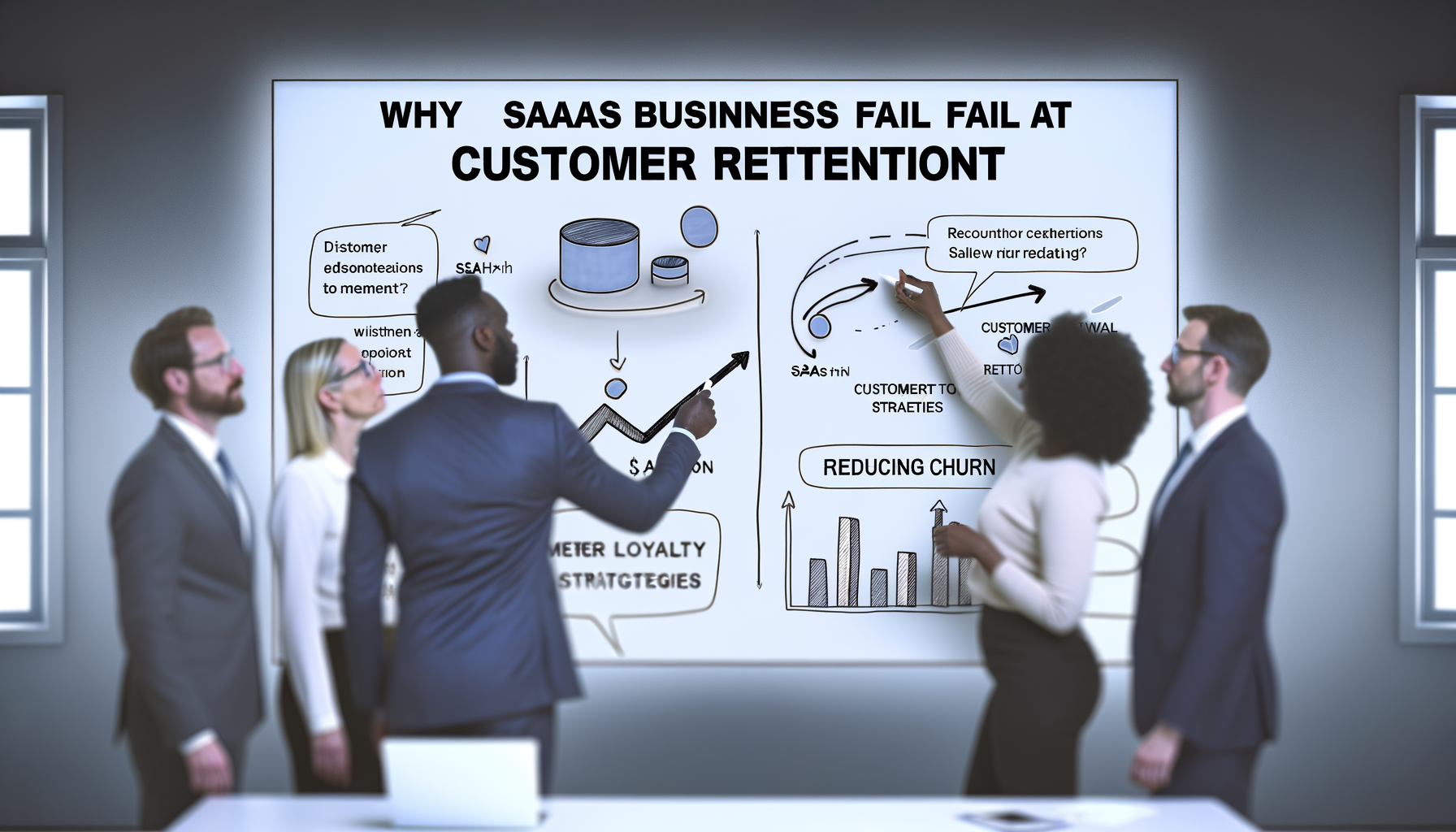
Why SaaS Businesses Fail at Customer Retention (And How to Fix It)
Introduction
In the bustling world of SaaS, customer retention is often the cornerstone of sustainable growth and profitability. But why do so many SaaS businesses stumble at retaining their customers? In this article, I delve into common pitfalls SaaS companies face regarding customer retention and provide actionable strategies to mend these growing pains, helping you reduce churn and foster loyal clientele. Navigating customer retention might seem challenging, but with the right tools and insights, it becomes an opportunity rather than an obstacle.
Understanding the Importance of SaaS Retention
One of the key reasons that elevates SaaS retention to the top of the priority list is profitability. Research consistently shows that it’s more cost-effective to retain current customers than to acquire new ones. The recurring revenue model inherent to SaaS businesses further amplifies the significance of retention. A higher retention rate not only reflects customer satisfaction and proficiency in your offerings but also turbocharges your business growth.
Common Retention Pitfalls
Many SaaS companies fall into similar traps regarding customer retention. Identifying these hurdles is the first step toward overcoming them.
1. Lack of Customer Engagement: Customer engagement is vital in keeping your clients interested and satisfied with your product. Without personalized touchpoints, communication can stagnate, leading to disengagement and ultimately, churn.
2. Ignoring Customer Feedback: Customers offer feedback, both solicited and unsolicited. Failing to listen can result in not just losing an individual client but potentially damaging your brand reputation as well.
3. Ineffective Onboarding Processes: A common error is a weak onboarding process that fails to showcase the value of the product effectively. An initial poor experience can set the tone for the entire customer journey.
4. Overwhelming Product Complexity: While advanced features are crucial, overwhelming customers with complexity can rapidly lead to dissatisfaction. Striking a balance between sophistication and usability is key.
Strategies to Reduce Churn and Improve Retention
Reducing churn and improving retention are critical to the long-term success of a SaaS business. Let’s explore some strategic methods to address these challenges head-on.
Enhance Customer Engagement
Developing a comprehensive engagement plan is imperative. Regular check-ins, personalized content, and active online communities can keep the dialogue with your customers ongoing. Utilize CRM tools to segment your audience and tailor your outreach to match their unique needs.
Prioritize Customer Feedback
Create formal and informal channels for customer feedback. Actively encourage users to share their experiences and, more importantly, show them that their voices matter by implementing their suggestions where feasible. This builds trust and demonstrates a commitment to continuous improvement.
Streamline the Onboarding Process
Design an onboarding journey that’s both simple and informative. Offer step-by-step guides, video tutorials, and live sessions to ensure that new users grasp the full functionality of your product. Rapid success during the initial stages can dramatically improve retention rates.
Simplify Product Complexity
Review your product offerings to identify and eliminate unnecessary complexities. Provide intuitive interfaces, contextual help, and resource libraries to empower users. Regular assessments of customer interactions with your product can unveil areas for simplification.
Leveraging Technology for SaaS Retention
The integration of AI and machine learning can significantly bolster SaaS retention strategies. Predictive analytics can help identify at-risk customers, enabling proactive retention measures. Additionally, employing automation tools in email marketing can personalize outreach, nurturing relationships and solidifying retention.
Conclusion
Navigating the challenges of SaaS retention doesn’t have to be an insurmountable task. By focusing on enhancing engagement, prioritizing customer feedback, optimizing onboarding, and simplifying complexity, you can pave the way for sustained growth and reduced churn. As you implement these strategies, I invite you to explore further insights and join the conversation around SaaS growth dynamics. Together, we can transform customer retention from a hurdle into a hallmark of our mutual success.

How to Overcome SaaS Customer Acquisition Challenges in 2025
Introduction
As we dive deeper into the digital age, the landscape of SaaS customer acquisition is evolving rapidly. The year 2025 brings its own set of challenges for entrepreneurs and startups striving to carve out their niche in the SaaS industry. The competition is stiffer, and consumers are becoming more discerning. So, how do you ensure that your SaaS product not only stands out but also thrives? Let me walk you through strategic growth hacks and proven marketing tactics that can help overcome these challenges and secure a competitive edge.
Understanding the 2025 SaaS Customer Acquisition Landscape
The SaaS market has seen exponential growth over the past few years, and with it, customer acquisition strategies have undergone significant changes. Traditional methods are no longer sufficient. In 2025, building solid relationships and understanding customer behaviour will be key. Here are some emerging challenges and solutions to tackle them:
1. Market Saturation: With thousands of SaaS products entering the market, getting noticed is harder than ever. To combat this, focus on creating a unique value proposition that addresses specific customer pain points. Identify what makes your product different and why a customer should choose it over others.
2. Customer Savvy: Today’s customers are more informed and have higher expectations. They seek value, functionality, and excellent customer service. Implement interactive demos and free trials to demonstrate how your SaaS addresses specific challenges. Additionally, invest in top-notch customer support to enhance satisfaction and loyalty.
3. Integrating AI and Machine Learning: As these technologies become more prevalent, customers expect SaaS solutions to leverage AI for enhanced personalization and efficiency. Ensure your product incorporates AI-driven features to meet these evolving expectations and remain competitive.
Strategic Growth Hacks for SaaS Customer Acquisition
I’ve learned through my entrepreneurial journey that growth requires strategic planning. Here are some effective growth hacks that you can incorporate into your SaaS marketing strategies:
Focus on Content Marketing
Quality content is crucial for attracting and retaining SaaS customers. Create in-depth blog posts, case studies, and instructional videos that position your brand as a thought leader in the industry. By providing valuable insights and tips related to your SaaS platform, you engage potential customers and begin building trust from the outset.
- Develop a content calendar that aligns with relevant seasonal trends or industry events.
- Use SEO optimization to ensure your content is easily discoverable on search engines.
- Guest post on reputable platforms to expand your reach and attract new audiences.
Leverage Social Proof and Testimonials
In the SaaS industry, social proof can significantly influence purchasing decisions. Encourage satisfied customers to leave testimonials and reviews on your website and third-party review sites. Highlight these testimonials in your marketing materials to build credibility and trust.
Implement Referral Programs
Referral programs can provide a powerful boost to your customer acquisition efforts. Offer existing customers incentives to refer friends and colleagues to your platform. This not only helps bring in new clients but also motivates current customers to remain loyal due to the rewards they receive.
Collaborating for Success
In 2025, collaboration is a key driver for growth. Entering mutually beneficial partnerships and collaborating with other SaaS providers or industry influencers can unlock new opportunities for customer acquisition. Joint ventures, co-marketing campaigns, and cross-promotions can expand your brand’s reach significantly.
Conclusion
Navigating SaaS customer acquisition challenges in 2025 requires a blend of innovative marketing tactics and a deep understanding of emerging trends. By focusing on personalized experiences, leveraging advanced technologies, and fostering a solid connection with customers, you can achieve substantial growth. Remember, entrepreneurship is a journey of continuous learning and adaptation. Stay abreast of the latest SaaS growth strategies to maintain your competitive edge. Feel free to follow my insights on Foundercrate as we explore more avenues for success in the startup world.

How to Create a High-Converting SaaS Landing Page
Introduction
Crafting an effective SaaS landing page is like setting the perfect stage for a successful performance. Every element, from the lighting to the actors, must complement one another to captivate the audience – or in our case, convert a visitor into a loyal customer. Imagine this: a visitor lands on your page, enticed by a promise of solving their biggest challenges – but leaves more confused or uninterested. The difference between capturing this potential customer and letting them slip away often hinges on how well the landing page is optimized for conversion. In this digital landscape, the art of creating a high-converting SaaS landing page can significantly impact your bottom line.
The Essence of a SaaS Landing Page
A landing page is not merely a placeholder on the internet; it’s a carefully orchestrated component of yourmarketing strategy. The core purpose is to drive conversions, whether through sign-ups, downloads, or leads for your sales funnel. Optimizing SaaS landing pages—especially with conversion rate optimization (CRO)—ensures these pages effectively convey the value proposition and action points without overwhelming or confusing visitors.
Your Unique Value Proposition
The unique value proposition (UVP) is the star of your landing page show. It should be compelling, succinct, and tell users exactly what’s in it for them. By clearly defining your UVP, you set the stage for why potential users should choose your SaaS product over the competition.
For example, if your software automates manual business processes while ensuring data security, your UVP might emphasize time savings and peace of mind.
Design and User Experience: Form Meets Function
Great design is the handshake of your digital platform —it’s the first impression that sets expectations. An intuitive, aesthetically pleasing design contributes significantly to an improved user experience (UX). Let’s look at some crucial design elements:
- Visual Hierarchy: Guide your user’s eye to the most critical parts of your page using size, color, and positioning. Ensure the call-to-action (CTA) stands out and naturally draws the visitor’s attention.
- Mobile Responsiveness: With the rise of mobile browsing, any landing page must offer a seamless experience across all devices.
- Speed is Key: Fast-loading pages reduce bounce rates. Compress images and deploy efficient coding practices to ensure top-notch loading times.
Persuasive Copywriting: Speak Their Language
While a picture speaks a thousand words, text communicates those crucial conversion messages. Good copywriting resonates with the reader’s challenges and aspirations. It should be crisp, compelling, and singularly focused on benefits rather than features. Utilize techniques like storytelling to contextualize problems and solutions, helping potential customers visualize themselves with your SaaS product.
Maximizing Conversions with Strategic Elements
Beyond aesthetics and verbiage, certain tactical elements boost the likelihood of conversion.
Effective Calls-to-Action (CTAs)
An effective CTA is the performing artist who wins the standing ovation. Every word, color, and placement of your CTA influences its success:
– Use action-oriented language, like “Start Your Free Trial” or “Unlock Premium Features.”
– Ensure it contrasts with your background, making it impossible to miss.
– Test different placements to find where it converts best.
Trust Signals: Building Confidence
Building trust is non-negotiable in digital interactions:
– Customer Testimonials: Showcasing real customer feedback and case studies adds authenticity and instills confidence.
– Security Badges: Highlight security certifications and compliance with data protection regulations.
– Client Logos: Featuring recognizable brand logos enhances credibility and communicates social proof.
The Art of Continuous Optimization
Creating a SaaS landing page is not an exercise of set-and-forget. It’s a dynamic process where constant iteration is key:
– A/B Testing: Experiment with different versions of elements like headlines, images, and CTAs to determine what resonates best with your audience.
– Analytics and Feedback: Use analytics to monitor performance and gain insights into visitor behavior, while feedback tools can capture user sentiment and input directly.
Conclusion
Ultimately, crafting a high-converting SaaS landing page is like composing a symphony. Each element, from the value proposition to the tiniest design detail, must work in harmony to captivate and convert. By focusing on clear messaging, optimal design, strategic trust signals, and ongoing optimization, you give your SaaS business the best chance of standing out in a competitive market. Start crafting compelling SaaS landing pages today and watch visitor interest transform into tangible conversions. For more insights or questions about SaaS strategies, feel free to connect with me, Toshendra Sharma. Let’s take your entrepreneurial journey to new heights together.

The Future of SaaS Integrations: APIs & No-Code Connections
Introduction
The Software as a Service (SaaS) landscape is evolving at a breakneck pace, reshaping how businesses operate and scale. As we forge ahead into this exciting digital future, two trends stand out as transformative forces: APIs and no-code platforms. These developments are not just tech talk — they’re cornerstones for any SaaS solution looking to enhance interoperability and offer unmatched advantages to both developers and users. In today’s post, I want to discuss how these tools are revolutionizing SaaS integrations and why they are essential for success in today’s business environment.
The Rise of SaaS APIs
APIs, or Application Programming Interfaces, have been around for quite some time, but their importance in the SaaS universe cannot be overstated. APIs serve as bridges, enabling disparate software systems to communicate seamlessly, making SaaS APIs a linchpin in driving efficiency and functionality. One of my core beliefs is that APIs vastly expand the horizons of what SaaS products can achieve. Thanks to APIs, businesses can:
- Automate repetitive tasks, thereby reducing the potential for human error.
- Create customized workflows that suit their unique processes.
- Access richer data sets by connecting multiple systems, enhancing data-driven decision-making.
The power of an API lies in its ability to unlock endless possibilities for integration, so it’s no surprise organisations that embrace SaaS APIs see improved productivity and innovation.
Empowering Businesses with No-Code Platforms
One of the most significant changes in the API economy is the advent of no-code platforms. These are designed to democratize software development, making integration accessible to those with little to no programming knowledge. Businesses can now stitch together SaaS applications within hours rather than weeks. As someone deeply invested in fostering innovation, I’ve seen these platforms do wonders. They allow:
- Non-technical team members to engage more directly in the tech stack, improving speed-to-market for new ideas.
- Rapid prototyping, facilitating a more iterative approach to product development.
- Reduced costs, as the need for extensive development resources diminishes.
In a world where time and agility are invaluable, no-code platforms are game-changers for small businesses and startups looking to gain a competitive edge.
The Impact of Enhanced Integrations
With robust API and no-code solutions, SaaS companies can offer a level of customization that was once the domain of costly and labor-intensive processes. Enhanced integrations mean that businesses can tailor their software ecosystems to better serve their objectives. Key benefits include:
- Streamlined operations: By connecting various SaaS applications, businesses gain a unified view of their operations, leading to smoother workflows.
- Better customer experiences: Integrated systems can provide more accurate data which translates to personalized services.
- Increased scalability: Modular API and no-code setups allow businesses to expand capabilities without overhauling existing systems.
These are not just talking points; they are fundamental shifts altering how companies leverage technology to stay ahead in a hyper-competitive marketplace.
Looking Ahead
The future of SaaS integrations definitely lies in embracing the potential that APIs and no-code tools offer. To remain at the forefront of technological solutions, it’s crucial to keep pace with these trends. I encourage businesses to actively explore these options to streamline processes and foster a culture of technological empowerment.
When we envision the SaaS landscape a few years from now, it’s quite apparent that companies embracing APIs and no-code tools will not just be participants but frontrunners in their industries. As we stand on the edge of this exciting transformation, the opportunities beckon for those visionary enough to seize them.
Conclusion
As we’re witnessing, APIs and no-code connections aren’t just fleeting trends—they are essential facets of the future of SaaS technology. By elevating how service platforms can integrate and operate together, we are opening doors to innovation and efficiency never known before. For those of you looking to stay ahead or even lead in this sphere, I invite you to follow my journey as I continue to explore these revolutionary tools. Let’s embrace the API economy and SaaS automation together and herald in a new era of software advancements.

How to Improve SaaS Email Marketing for Better Conversions
Email marketing is a powerful tool for SaaS businesses. With the potential to drive significant conversions, it’s essential to understand how to craft effective email campaigns that resonate with your audience. But how exactly can one improve their SaaS email marketing for better conversions? Here, I’ll share some insights drawn from successful strategies and personal experiences in the SaaS marketing field.
Understanding the Basics of SaaS Email Marketing
Email marketing is not just about sending promotional messages to your subscribers. It’s about creating meaningful interactions that make your prospects feel seen, understood, and valued. The goal is to nurture leads until they are ready to make a purchasing decision. Understanding this fundamental principle is the first step toward optimizing your email marketing for better conversions.
1. Segmentation: Target Right, Convert Better
One of the most critical components of SaaS email marketing is segmentation. By dividing your email list into smaller, more manageable groups based on specific criteria (like industry, company size, or past behaviours), you can tailor messages that speak directly to each segment’s needs.
For instance, not all leads are at the same stage of the buying journey. By recognizing where a lead is within this journey, you can provide the most relevant content, thus increasing the likelihood of a conversion. Recent studies suggest that segmented campaigns can result in a 760% increase in revenue. Don’t underestimate the power of personalization within your SaaS email marketing strategy.
2. Crafting Compelling Content
The content of your emails is arguably the most crucial factor in converting your leads. Every message should deliver value, address specific pain points, and provide actionable solutions.
Here’s how you can ensure engaging content:
- Clear and Concise: Nobody has the time to read lengthy paragraphs. Keep your emails short, to the point, and engaging.
- Strategic Use of CTAs: Ensure your call-to-action buttons are easily accessible, straightforward, and compelling.
- Leverage Storytelling: Share success stories or case studies to demonstrate the real-world impact of your solutions.
Remember, the main aim is to lead them naturally to the next step in your sales funnel.
3. Timing: The Secret Ingredient
Just like in comedy, timing in email marketing can be everything. The frequency and timing of your emails can significantly influence your open and conversion rates. You want to ensure your communications come across as strategic rather than spammy.
Experiment with different times and days of the week to find when your audience is most likely to engage. Analysing your open rates and conversions over time will give you invaluable insights to fine-tune your timing strategy.
Data-Driven Decision Making for Conversion Optimization
1. A/B Testing Campaigns
A/B testing isn’t just a buzzword; it’s a necessity. By testing different email elements—such as subject lines, design, body content, and calls to action—you can determine which variables work best for your audience. These insights are invaluable for conversion optimization.
2. Monitoring and Analytics
Every email campaign provides a wealth of data, from open rates and click-through statistics to the final conversion numbers. Utilise tools like Google Analytics or SaaS-specific platforms to track how well your strategy is performing. Continuous monitoring allows you to adjust and improve, honing your approach to be more targeted and effective over time.
Conclusion: Turning Prospects into Customers
The journey from lead to loyal customer begins with a sound SaaS email marketing strategy. By focusing on segmentation, crafting compelling content, paying attention to timing, and employing data-driven decision-making, you’re setting yourself up for email marketing success and, ultimately, higher conversions.
Over time, these practices not only improve your email marketing efforts but also build stronger relationships with your audience. For more insights into how you can drive growth and success with your SaaS startup, be sure to follow my journey and tips on Foundercrate. Together, let’s turn more prospects into satisfied customers!
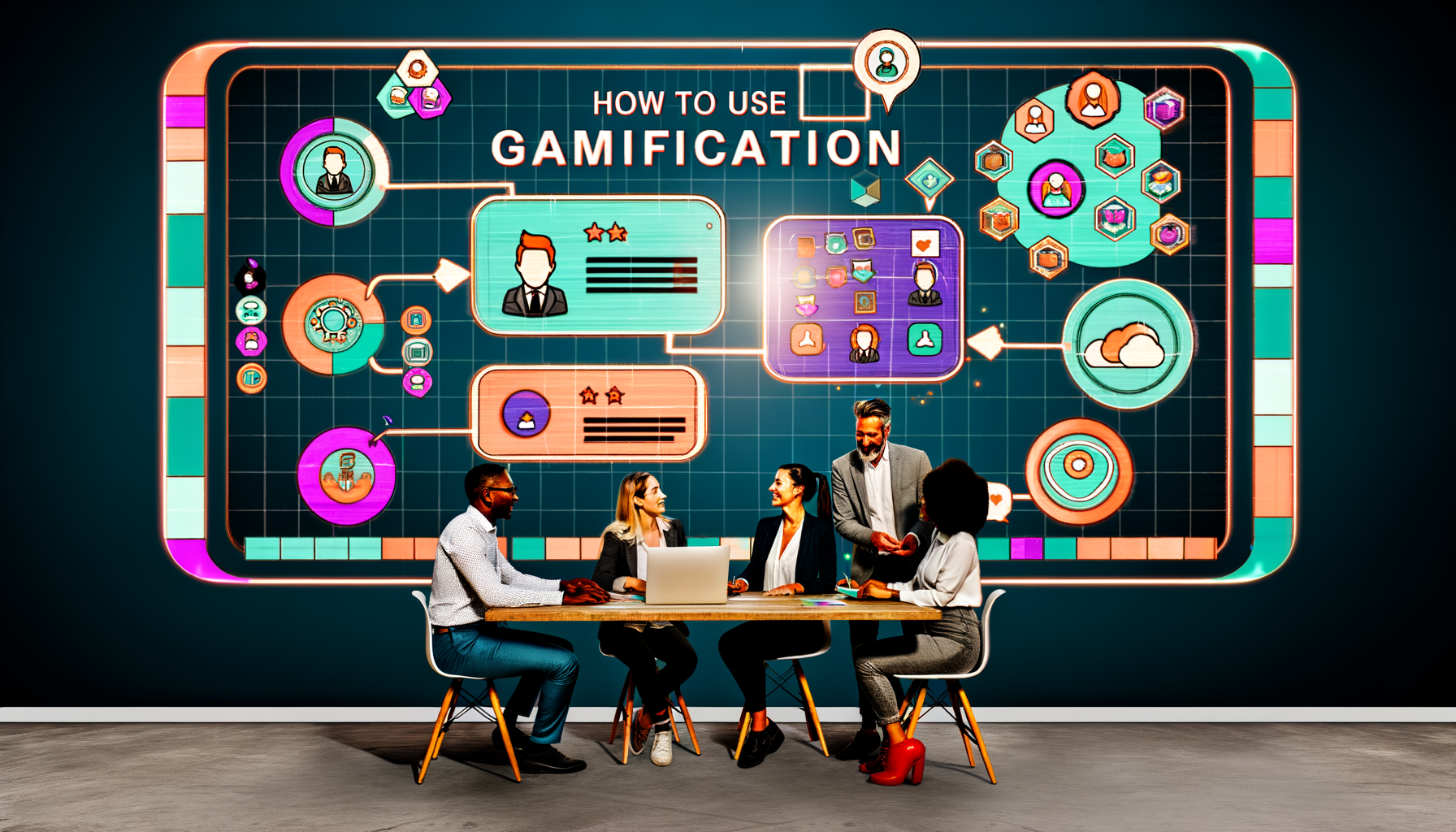
How to Use Gamification to Improve SaaS User Engagement
Unleashing the Potential of Gamification in SaaS for Enhanced User Engagement
The realm of SaaS is a fiercely competitive landscape where user engagement is the key to survival and growth. In this ever-evolving space, maintaining and enhancing user interaction isn’t just an option—it’s a necessity. One of the intriguing strategies that can revolutionize how SaaS platforms interact with users is gamification. Let’s delve into how employing gamification techniques can transform user engagement, drive retention, and give your SaaS product the competitive edge it deserves.
Understanding Gamification: More Than Just Fun and Games
Gamification is the art of applying game-design elements and principles in non-game contexts. For SaaS companies, this means integrating typical game elements such as point scoring, leaderboards, and rewards to influence user behaviour, thereby enhancing user engagement and retention. The appeal of gamification lies in its ability to tap into human psychology, triggering motivation, satisfaction, and loyalty.
Why Gamification is Essential for SaaS Engagement
Incorporating gamification into your SaaS strategy can lead to significant uplift in user engagement metrics. Here’s why:
- User Motivation: Gamification leverages intrinsic and extrinsic motivators, driving users to interact more frequently with the software.
- Active Participation: By incorporating game mechanics, SaaS platforms can encourage active participation, significantly reducing churn rates.
- Competitive Edge: Gamification can offer a unique differentiator in crowded markets, making your product more engaging and fun to use.
- Performance Feedback: Users benefit from immediate feedback through scores, progress bars, or badges, which can encourage continued engagement.
Implementing Gamification in SaaS Platforms
Turning your SaaS platform into a hub of engagement through gamification requires strategic implementation:
1. Leaderboards
Leaderboards can spur healthy competition among users by showcasing top performers. It’s essential for the leaderboard to be updated regularly to reflect real-time performance and spark cumulative user interest.
2. Rewards and Badges
Offering incentives such as badges, points, or virtual trophies can motivate users to complete tasks or adopt certain behaviours. These rewards act as tangible acknowledgment of their achievements, encouraging regular interaction.
3. Progress Tracking
Implementing progress bars or similar tracking features can provide users with a visual representation of their achievements and milestones. This not only clarifies the path to completion but also inspires users to sustain their efforts to achieve full completion.
Best Practices for Effective Gamification
To unlock the full potential of gamification in SaaS, consider the following best practices:
Understand Your Audience
Every target audience is different. Understand what motivates your users to tailor gamification elements that are most likely to appeal to them.
Ensure Transparency
Users should clearly understand the reward system and the criteria for earning points or badges. Transparency builds trust and encourages honest participation.
Balance Challenge and Reward
Keep the game mechanics balanced. If tasks are too easy, users may lose interest, while overly difficult tasks can lead to frustration. Adjust levels of challenge to maintain user interest and satisfaction.
Real-World Examples of Effective SaaS Gamification
Numerous SaaS platforms have successfully embraced gamification, witnessing impressive results in user engagement:
- Duolingo: By gamifying language learning with streaks, XP points, and leaderboards, Duolingo has made learning highly addictive and enjoyable.
- Slack: With fun challenges and feedback loops, Slack enhances collaboration and user participation through subtle gamification techniques.
Conclusion: Gamification as a Game Changer
Integrating gamification into your SaaS strategy can significantly uplift user engagement and foster customer loyalty. While the core principle remains to keep users active and motivated, it’s crucial to be mindful of the strategic implementation that aligns with your business goals and user expectations. As a SaaS founder, embracing gamification could be the next step to elevating user experience and propelling your product into a league of its own.
For more insights and innovative strategies in SaaS user engagement, feel free to explore further insights on Foundercrate or connect with me, Toshendra Kumar Sharma. Together, we can build an ecosystem where SaaS thrives through creativity and engagement.
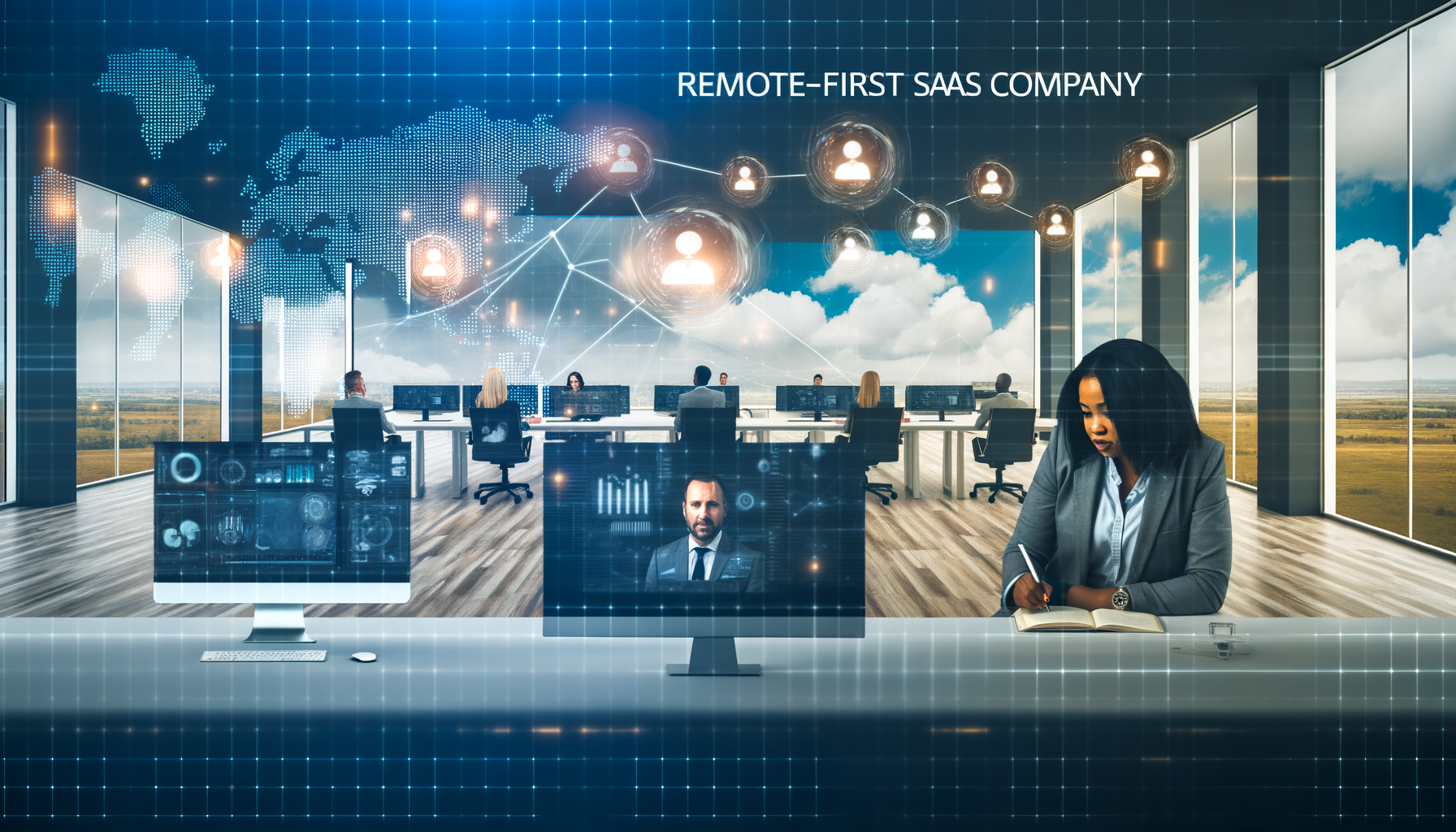
Building a Remote-First SaaS Company: Challenges & Opportunities
Introduction
The world of software as a service (SaaS) has rapidly evolved, embracing remote-first models as a new norm. As a founder of Foundercrate, I’ve navigated the dynamic landscape of building a remote-first SaaS company, encountering both challenges and opportunities along the way. This article delves into the essentials of establishing a remote SaaS operation, offering insights into overcoming hurdles and leveraging the advantages of a distributed workforce.
Embracing a Remote-First Mindset
Adopting a remote-first approach requires a significant mindset shift. One must move away from traditional office-centric paradigms to a culture that values flexibility and autonomy. This transition begins by rethinking how teams collaborate and communicate—focusing on cloud-based tools and processes that keep team members connected, regardless of location.
Key tools in our arsenal include platforms like Slack for real-time communication and Asana or Trello for project management. These have proven indispensable in ensuring seamless workflow and maintaining productivity across distributed teams. Such tools help bridge the geographical divide, ensuring that all members, whether they’re in New York or New Delhi, remain aligned with the company’s objectives.
Overcoming Communication Barriers
One of the most significant challenges of a remote SaaS setup is communication. The absence of face-to-face interactions can lead to misunderstandings or the omission of crucial information. To counteract this, I prioritize establishing clear communication protocols.
We implement structured communication channels and encourage transparency. It’s vital to clearly articulate goals and expectations while encouraging open feedback. Regular video meetings can foster stronger team relationships and reduce feelings of isolation, helping maintain a robust company culture even though we may not share a physical workspace.
Building a Cohesive Company Culture
Creating a cohesive culture in a remote SaaS company can be daunting, but it’s critical for success. Cultural alignment ensures everyone moves in the same direction, sharing common values and goals. We’ve cultivated a culture of inclusivity and openness by celebrating diversity and fostering an environment where everyone’s voice is heard.
Regular virtual events, both formal and informal, help maintain team morale. Initiatives like virtual coffee breaks or team-building exercises encourage camaraderie, offering a break from daily tasks while reinforcing our company’s ethos.
Recruiting and Retaining Talent
Remote work opens up a global talent pool, increasing opportunities to find the right fit for your company’s needs. However, attracting and retaining top talent requires a strategic approach. We emphasize clear value propositions, such as flexible working hours and opportunities for professional growth, which are particularly appealing in the current job market.
Building a compelling employer brand that stands out requires showcasing your company’s commitment to employee well-being and work-life balance. Offering training and development programs can also serve as a significant draw for professionals seeking to grow their skills in a supportive environment.
Navigating Security Challenges
Security is a non-negotiable priority for any SaaS business, especially with a remote-first model. The increased reliance on various digital tools calls for stringent security measures to protect sensitive information. Implementing robust authentication processes and regular security audits can mitigate risks associated with distributed work.
We’ve invested in state-of-the-art encryption techniques and ensure our team is regularly updated with the latest security protocols. This proactive approach helps us maintain client trust and safeguard our company’s reputation in the competitive SaaS landscape.
Conclusion
Building a remote-first SaaS company is a journey filled with unique challenges and incredible opportunities. By embracing technology, fostering a connected company culture, and prioritizing security, it is possible to create a thriving distributed workforce. As I continue to explore and adapt in this space, I invite fellow founders and aspiring entrepreneurs to follow my journey at Foundercrate, where I share more insights and tips on navigating the exciting world of SaaS operations.
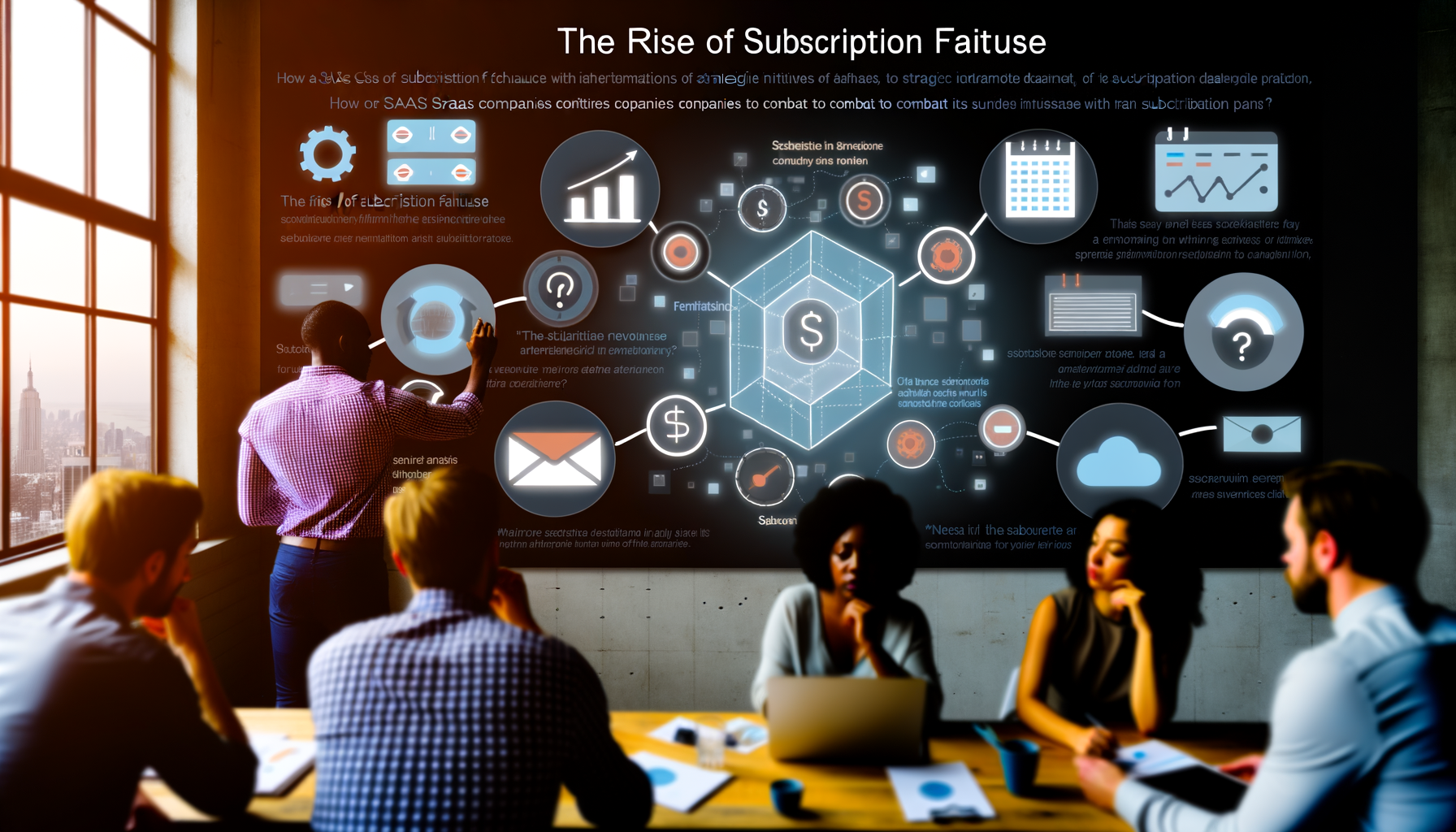
The Rise of Subscription Fatigue: How SaaS Companies Can Combat It
Understanding Subscription Fatigue: The Silent Challenge for SaaS Companies
As a founder of a SaaS company, I’ve seen firsthand how the landscape of software as a service has evolved dramatically over the years. Today, we face a significant challenge: subscription fatigue. This term refers to the weariness customers feel when overwhelmed by the sheer number of subscription services they manage. As convenient as the subscription model can be, too many options often lead customers to consolidate their subscriptions or cancel them altogether. This article delves into the nature of subscription fatigue and explores effective strategies SaaS companies can employ to ensure high retention and reduce churn.
The Roots of Subscription Fatigue
Subscription fatigue arises when customers encounter exhaustion from managing multiple recurring payments. With everything from entertainment to productivity tools requiring monthly fees, users can quickly feel trapped in a web of ongoing commitments. This phenomenon is worsened by the financial drain of subscriptions that, in many cases, go underutilized. A recent survey revealed that consumers regularly underestimate the actual costs of their subscriptions, leading to occasional budget shocks and resulting in canceled services.
Why SaaS Companies Should Be Concerned
For SaaS companies, subscription fatigue directly threatens customer retention rates. Here’s why:
- Increased Churn: Customers looking to reduce their monthly expenses may choose to unsubscribe from services they deem non-essential.
- Reduced User Engagement: Users overwhelmed by their subscriptions might not fully engage with your service, diminishing its perceived value.
- Negative Word of Mouth: Frequent cancellations due to subscription fatigue can lead to frustration, potentially resulting in negative feedback and reviews.
Combatting Subscription Fatigue with Retention Strategies
In the face of these challenges, it’s crucial for SaaS companies to adopt strategies that not only combat subscription fatigue but also enhance their service offerings. Here’s what I recommend:
1. Enhance the Value Proposition
One of the most effective ways to tackle subscription fatigue is to emphasize your product’s unique value. Rather than focusing solely on features, illustrate the problem your service solves and how it benefits the customer’s daily life or business operations. Providing clear, tangible outcomes allows users to see the irreplaceable value your service adds, justifying the cost.
2. Optimize User Engagement
Engaged users are less likely to experience subscription fatigue. Therefore, investing in tools that bolster user interaction is vital. Ensure your interface is intuitive and that users quickly access essential features. Regularly update your service and communicate these updates effectively, ensuring your customers know exactly how your service evolves to meet their needs.
3. Implement Flexible Subscription Models
Customers appreciate flexibility. Offering various subscription tiers, including “pay-as-you-go” models or pause options, affords customers the breathing room they need to manage their finances without fully severing ties with your service. By presenting customizable plans, you empower users with choice and control, reducing the pressure that leads to subscription fatigue.
4. Foster Strong Communities
Creating a community around your SaaS product helps users connect with peers and discover new ways to derive value from your service. Whether through forums, social media groups, or virtual meetups, these communities can sustain engagement and foster loyalty, counteracting the urge to unsubscribe.
Leveraging Customer Feedback
The pivotal element in addressing subscription fatigue lies in understanding your customers. Regularly seek feedback through surveys or direct client interactions to understand their experiences and pain points. This feedback allows you to anticipate needs and tailor your offerings accordingly. Adaptation is the key to maintaining relevancy in a crowded marketplace.
Conclusion: The Path Forward
Subscription fatigue is a tangible concern hindering the growth of many SaaS companies. By understanding its underlying causes and employing strategies designed to enhance customer retention and satisfaction, we can overcome this hurdle. As a founder, my goal is to innovate and adapt constantly, ensuring that my product not only meets the immediate needs of users but also evolves alongside them. For more insights into the SaaS world and effective strategies to minimize churn, stay connected. Let’s build resilient businesses together.
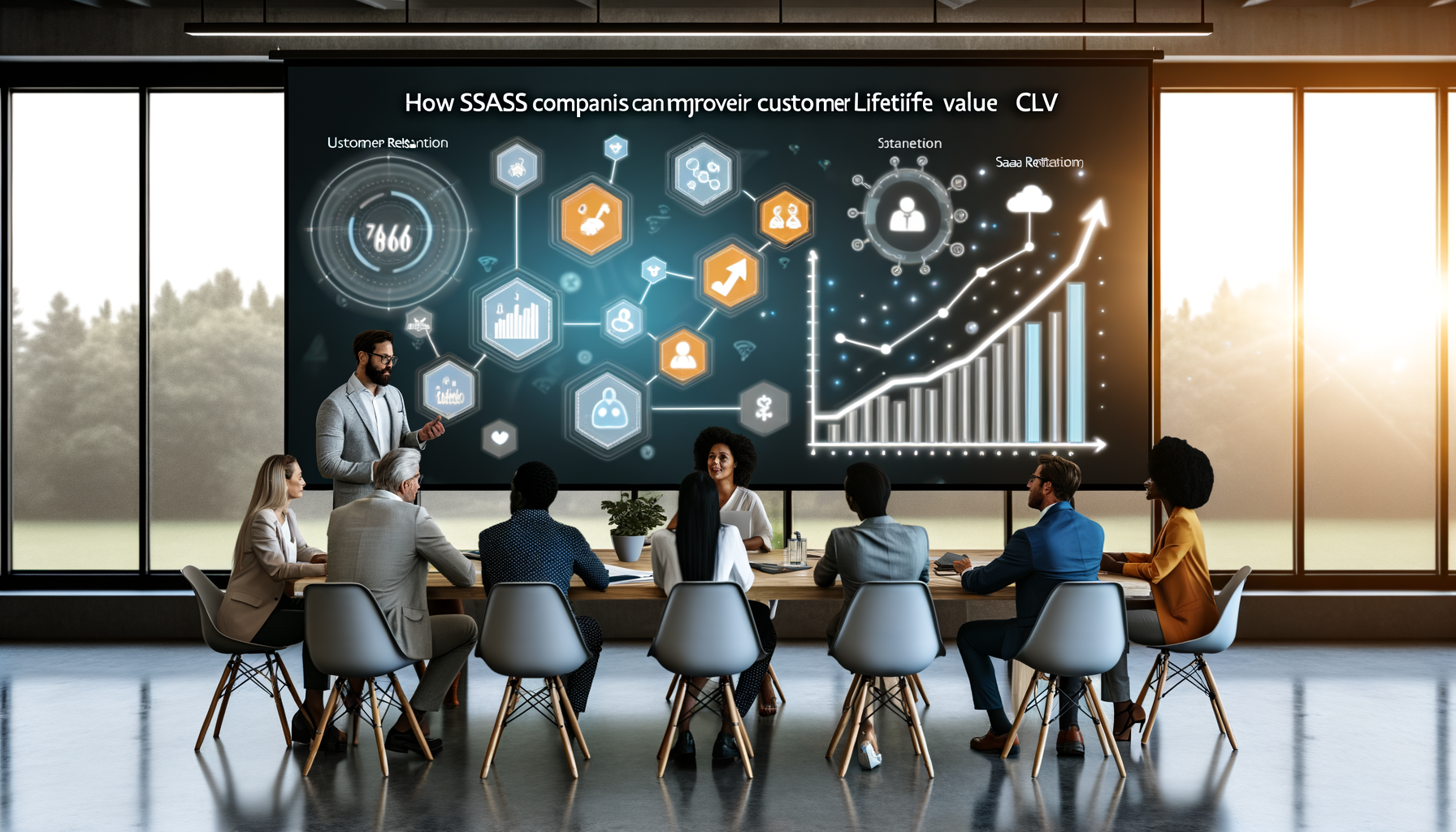
How SaaS Companies Can Improve Their Customer Lifetime Value (CLV)
In today’s fast-paced market, Software as a Service (SaaS) companies face unique challenges in not only acquiring customers but also engaging and retaining them over time. Focusing on Customer Lifetime Value (CLV) is critical, and improving it can be a significant catalyst for revenue growth and business sustainability. Having navigated the entrepreneurial waters myself, I have realized the invaluable role that optimized CLV plays in creating enduring success. In this piece, I’ll share insightful strategies on how SaaS companies can effectively boost their Customer Lifetime Value.
Understanding Customer Lifetime Value in SaaS
Before diving into strategies, it’s crucial to understand what SaaS CLV entails. CLV is a prediction of the net profit attributed to the entire future relationship with a customer. For SaaS companies, where the business model often relies on recurring billing, maximizing CLV means ensuring long-term customer relationships. This involves a delicate balance of customer acquisition, satisfaction, and retention efforts to optimally grow your revenue.
1. Leverage Data Analytics for Targeted Customer Retention
Data-driven decision-making is an essential element in understanding customer behavior. Deep analysis of customer data allows you to identify patterns and trends related to user engagement and churn. By segmenting your customer base using behavioral data, you can tailor-specific retention strategies to different cohorts. For instance, if data shows a drop in engagement after a certain period, you can proactively devise strategies like offering exclusive deals or personalized product tips to re-engage those users.
Moreover, employing predictive analytics can forewarn potential churn, giving you the upper hand to intervene timely. This can significantly boost your customer retention strategies, ultimately enhancing the SaaS CLV.
2. Enhance the Onboarding Experience
The onboarding process is often the first prolonged interaction new users have with your service, making it a golden opportunity to set a positive tone. A seamless onboarding experience helps in acclimating users to your platform’s value, thereby reducing early-stage churn and increasing long-term engagement.
Consider implementing interactive guides, webinars, and support channels that give new users a comprehensive walkthrough of the features. The aim is to ensure that customers not only understand how to use the software but also see its immediate value in their operations. A well-executed onboarding strategy is a powerful catalyst for customer loyalty, an essential ingredient in boosting CLV.
3. Adopt a Customer-Centric Product Roadmap
In an industry driven by rapid innovation, customer feedback should be the compass guiding your product roadmap. Engaging customers in regular feedback loops allows you to identify pain points and emerging needs, providing you a platform to adapt your offerings accordingly.
Conduct surveys, initiate user focus groups, and employ feedback forms to capture insights directly from your clientele. The goal is to create a product development strategy that is responsive to customer needs, ensuring your SaaS evolves in alignment with user expectations. A customer-centric product not only minimizes churn but increases the perceived value of your service, ultimately enhancing the CLV.
4. Implement a Tiered Pricing Model
A tiered pricing strategy can cater to different customer segments, enhancing their value perception and prolonging their engagement. Providing various pricing tiers that align with different stages of business growth enables customers to scale up with your service rather than outgrow it.
For example, offering a basic tier for smaller teams and startups, alongside premium options for more extensive, enterprise-scale accounts, ensures that there is a feasible path for your customers to increase their spend as their own revenue grows. This strategy not only boosts current revenue but enhances customer retention, effectively increasing the overall CLV.
5. Foster a Community around Your SaaS
Building a community around your product creates a sense of belonging and loyalty among users. Organize events, webinars, and discussion forums where users can interact, share insights, and provide feedback. This not only strengthens user bonds with the brand but transforms your customer base into advocates.
Empowered communities tend to be highly loyal, leading to longer subscription periods and, therefore, an increased Customer Lifetime Value. A vibrant community is an underutilized asset that bolsters both engagement and retention.
Conclusion: Unleashing CLV Potential
Improving SaaS CLV is not a one-time endeavor but a multifaceted approach that considers customer engagement, satisfaction, and loyalty. By employing strategies like data-driven insights, enhanced onboarding, customer-centric development, strategic pricing, and fostering community, SaaS companies can effectively boost their CLV, driving sustainable revenue growth.
I encourage you to analyze your own processes and see where these strategies can be integrated. For more insights and methodologies on entrepreneurship and SaaS monetization, follow along my journey as we continue to discover parallels between customer relationships and success in the tech world.

Why SaaS Businesses Should Invest in Community Building
Today, as a SaaS founder with a passion for building lasting relationships, I want to delve into a topic close to my heart—community building in the SaaS sector. If you’re a fellow entrepreneur or a curious mind dabbling with Software as a Service, you’ll find that cultivating a vibrant SaaS community is not just a nice-to-have; it’s a strategic imperative.
The Power of Community in SaaS
Having been through the trials of launching and sustaining a SaaS business, I can vouch for the profound impact an active community has on user engagement and customer loyalty. Communities transform a transactional product service into an engaging user experience. They are the epicenter of user engagement, where customers find support, share feedback, and evolve into brand advocates. This user-driven engagement is not only heartwarming to witness but is also a strong predictor of organic growth.
User Engagement: More than Just Buzzwords
In the bustling world of SaaS, buzzwords like ‘user engagement’ and ‘customer satisfaction’ often dominate discussions. But what do they really mean in practice? User engagement goes beyond regular user interactions; it fosters deeper connections via interactive platforms such as forums, webinars, and social media groups. These communities become a space where users feel comfortable sharing queries, ideas, and insights. The organic dialogue doesn’t just enhance customer experience; it enables the business to glean valuable feedback—fueling innovation and improvement.
Strategies for Building a SaaS Community
Over time, I’ve learned that successful community building is both an art and a science. Here are some strategies that can help in setting the foundation for an effective SaaS community:
- Create Value-Driven Content: Develop content that addresses user needs and adds value to their journey. Tutorials, case studies, and industry insights can boost trust and engagement.
- Leverage Technology: Utilize platforms tailored to community interaction. User-friendly interfaces for discussions and resource sharing foster a sense of belonging.
- Encourage Feedback and Participation: Efforts to solicit and act on user feedback demonstrate that you value your community members, building a culture of mutual respect and growth.
- Host Events: Webinars and virtual meetups can bring members together, encouraging knowledge sharing and networking.
The SaaS Branding Advantage
Community building isn’t just about keeping users engaged—it’s about weaving them into the fabric of a brand’s identity. Through this integration, your SaaS company becomes synonymously linked with community values and collaborative growth, ultimately strengthening your SaaS branding. A well-engaged community reflects positively on your brand, enhancing its reputation and extending its reach.
The Long-Term Payoff
Building a SaaS community demands an investment of time and resources, but the long-term dividends are significant. Not only does an engaged community enhance user experience, but it also powers customer engagement and retention. When users feel part of a community, they are less likely to churn—which means higher customer lifetime value.
The stories and testimonials shared within your community serve as organic marketing tools, driving word-of-mouth referrals. These advocates become your most effective brand ambassadors, promoting your SaaS solution with an authenticity that no marketing budget can buy.
Concluding Thoughts
Reflecting on my entrepreneurial journey, it’s clear that community building in SaaS is not just about connection—it’s about sustaining a thriving ecosystem where every member can contribute and derive value. It’s about fostering an environment where users evolve from satisfied customers into passionate advocates. I want to encourage you to embrace the idea of community, and if you haven’t, let’s start building together. The relationships nurtified here can define the trajectory of your SaaS business.
As we continue to navigate this ever-evolving digital landscape, let’s share our insights, support one another, and keep the spirit of collaborative growth alive. Follow along for more on how we can each leverage the power of our communities to drive the next wave of innovation and success.
